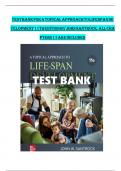Summary
Summary Recent Advances in Anesthesiology (Volume 2) Anesthesia: A Topical Update - Thoracic, Cardiac, Neuro, ICU, and Interesting Cases
- Institution
- American Intercontinental University (AIU)
Despite one’s best effort and the efforts of various professional societies, it is often difficult to keep abreast in all aspects of anesthesia. Over time, every practitioner settles into a daily practice and keeps current in that area. However, the nature of modern anesthetic practice require...
[Show more]












